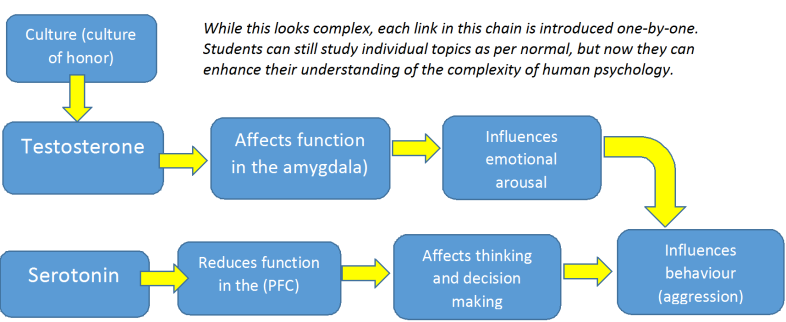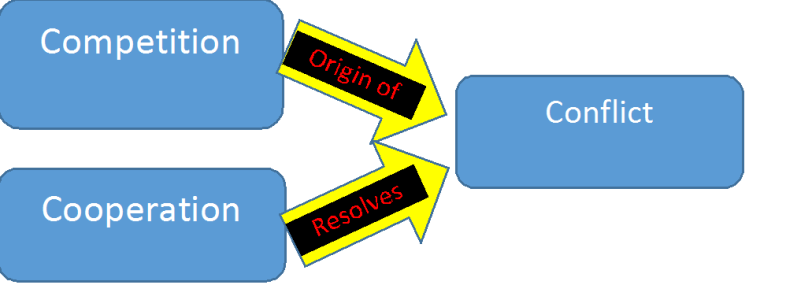When it’s time to teach the new course, if you’re a bit savvy in your curriculum design you can exploit overlaps, cut content, and best of all – enhance student understanding of psychology. How do we do all this? In this post I’ll walk you through some helpful hints and show you the value of constructing relationship chains.
Keeping it Simple
I had to devise the metaphor of a relationship chain when I started writing and designing a thematic course that combined all three approaches with the options topics (and writing the book to go with it, IB Psychology: A Student’s Guide). The overlap of options with biological, cognitive, social and cultural factors all in one unit got really messy. This was not good for the order, structure and logic that me and my students desire.
So in order to keep it simple, I came up with the metaphor of a relationship chain that simply outlines how things are related to one another. This is how the themantic model of curriculum design was born.
Relationship chains are the heart of the themantic model of curriculum design and it’s what separates a themantic approach from a thematic one.
Example Topic: “The Brain and Behaviour”
Psychology is the study how variables relate to behaviour. So in Criminology topic 2.1, we begin with a very basic relationship chain:
- Damage to the brain (prefrontal cortex), can influence behaviour (cause aggression).

The connecting of building blocks makes relationship chains. All topics (and exam questions) in IB Psychology require students to use building blocks to construct relationship chains.
In just two lessons, students learn about the brain and behaviour (a topic in the biological approach).
But this doesn’t allow students to understand why damage to the prefrontal cortex can cause aggression. So in our next topic we add another link to the relationship chain from the cognitive approach:
- Thinking and Decision Making.

By gradually adding links, we enhance understanding, reduce content and give students more opportunities chance to rehearse information (a key component of learning!)
Now in four lessons I can teach a topic from the cognitive approach (thinking and decision making) just like I would normally, beginning with the dual processing model of judgement and decision making and then moving into how damage to a part of the prefrontal cortex (the vmPFC) can affect this thinking and decision making. So students can now:
- Describe the dual processing model of judgement and decision making (Cog Topic)
- Explain how it’s shown in a study (see study here)
- Apply this to explain how thinking and decision making can influence behaviour (a wild card option that might appear in exams).
- Explain the localized function of using system two process in the vmPFC (Bio Topic)
So in the themantic model of curriculum, we still teach topics and the topics have the same relationships as outlined in the course guide:
- How does brain function → influence behaviour
- Show how a study → demonstrate localization of brain function
- How can thinking and decision making → influence behaviour
- How can thinking and decision making → be shown in a study
But by gradually introducing new links in relationship chains, we’re enhancing understanding of the topics, and also how behaviour (e.g. aggression) can be the product of multiple variables interacting with one another. This latter point is the massive benefit of going with a course that combines options and core.
You can see this planning in practice in our sample topics from the textbook.
Later in the unit we introduce variables that might be influencing the prefrontal cortex, because not everyone who’s aggressive has damage to their PFCs (although most criminals have head trauma from childhood). So we look at how serotonin might influence the PFC during times of social threat, which could explain serotonin’s link with violence.
Towards the end of the criminology unit, our relationship chains look something like this:

So now not only do students have an excellent argument for how specific variables (e.g. serotonin) can influence behaviour (aggression), they also have good counter arguments, too (like alternative explanations based on other variables). So we’ve prepared students to write essays on all topics writing without adding more content!
I’m interesting to hear how logical and comprehensible this paradigm is, so please feel free to leave comments.
Cut Content in the Options
We now only have 20 hours for the options, which means if we want to develop deep conceptual understanding, carefully constructing meaningful relationship chains is the only way to go.
For example, take two of the human relationships topics:
- Origins of Conflict and Conflict Resolution
- Competition and Cooperation.
Now, for some reason, we haven’t been told what students are expected to understand about competition and cooperation, so why not combine these topics to make our own relationship chains that develop conceptual understanding and reduce content all at the same time:

The options in the new guide are rife for constructing meaningful relationship chains.
We can use Sherif’s realist group conflict theory and the Robber’s Cave Experiment to show how competition between groups can be an origin of conflict. We can use this same theory and study combination to show strategies for conflict resolution.
If you’re planning on using IB Psychology: A Student’s Guide as your classroom textbook, you can rest easy that all this hard work has been done for you.
If you wanted to, you could also use this same theory for its original purpose: explain the origins of prejudice and discrimination between groups, which is another topic in Human Relationships:

RCT and the Robber’s Cave was originally designed to explain prejudice and discrimination, so it could be used here, too. However, I will direct my students towards using social identity theory as an origin of prejudice and discrimination.
Developmental Psychology
If you’re planning on using my textbook, the curriculum is already planned out for you, as much as you want it to be. Of course, you can still add and remove topics for many parts of the course. But if you want to develop your own units, here’s an example of the thought-processes I would go along when looking at topics in development psychology, just to provide an example.
Let’s start by listing some interesting topics where I can see potential overlaps:
- Influences on cognitive and social development
- Childhood trauma and resilience
- Poverty/socio-economic status
- Cognitive development
- Brain development
Now, actually I’ve got a head-start here because most of these topics are covered in my course (and book), but I did this by accident. I think the influence of poverty, neglect and trauma on childhood development are valuable concepts for all students to understand, so I didn’t want to leave them out. If we’re going to use education to effect social change, it needs to start with learning about things like this, I think.
So here’s how my relationship chains look like for these topics:

Constructing relationship chains is really fun, if you’re a curriculum nerd like me!
Now when a student is asked any exam question about any one of these topics from the developmental option, they can use this relationship chain to construct excellent answers.
A note on classroom practice
I don’t hammer home the metaphor or use the terminology “relationship chain” on a daily basis in class. It’s a bit artificial and detracts from the simple study and fascination that comes with learning about these topics. I’d rather that the process of making these connections was a more organic and authentic for students.
Although I do show them diagrams like these and talk them through the steps, especially at the end of topics, not at the beginning.
When it comes time to review, using relationship chain metaphors can be a good way for students to ensure their understanding. Weaker students also benefit from constructing these diagrams (which after all are just mind maps/flow charts – the whole purpose of graphic organizers are for students to deepen understanding by seeing how things are related).
Final Thought
I know this is what many people do already but just don’t call it by such a name. I don’t claim for the themantic model of curriculum design to be revolutionary, it’s evolutionary. The visual metaphors of relationship chains and building blocks just serve like any figurative language: they turn abstract ideas into concrete details. The hope is that this will help teachers teach, and students learn.
The metaphor really helps with course designing, even at the topic level. When you’re choosing a topic to teach, identify the relationship chain and that becomes your conceptual understanding. If you’re clever about it (like I’ve tried to be in my new course), you can end up teaching an HL course in 180 hours, freeing up lots of time to just enjoy the love of teaching and studying psychology.
Where we hope to go in the future is to be able to publish teachers’ units of work that use the themantic model. This way we can have shopping lists filled with potential units that we can use and adapt for our own classrooms.
I’m always open to feedback and criticism, so feel free to leave comments.
Travis Dixon is an IB Psychology teacher, author, workshop leader, examiner and IA moderator.
